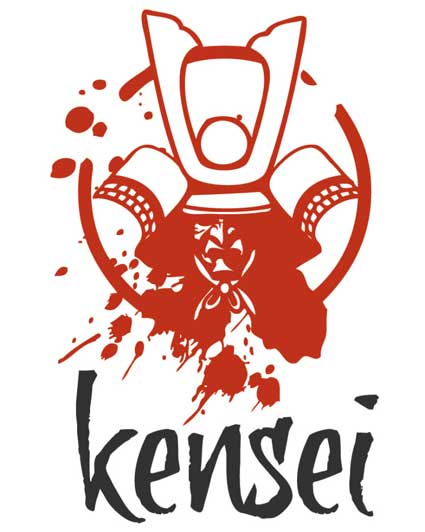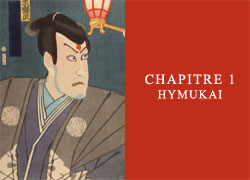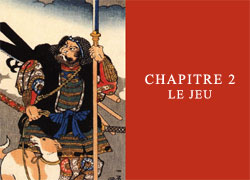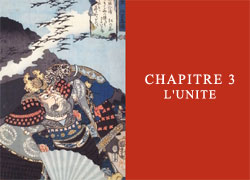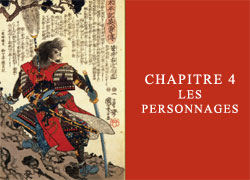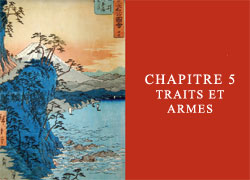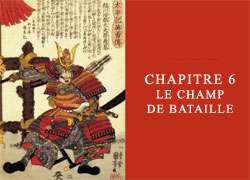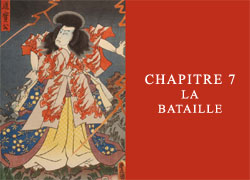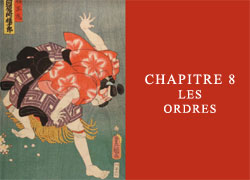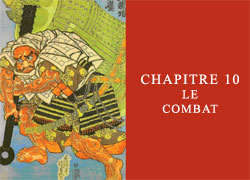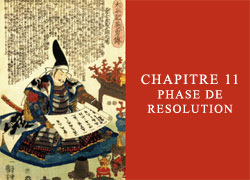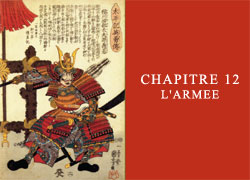8 : 1 ORDERS AND ACTIONS PH ASE
In this phase you first have to assign what are known as "Taisho Orders" and then, your units and characters carry out any actions derived from those order
Dans cette phase, vous devez d'abord attribuer ce qu'on appelle les "commandes Taisho" et puis, vos unités et des personnages exécuter toutes les actions dérivées de celles ordre
8 : 2 COMM ANDMENT POINTS
The Taisho have some Commandment Points which they can use to regroup units, use abilities or assign Strategic Orders. Depending on the type of general leading the battle there are more or less Commandment Points available:
Le Taisho ont quelques points de commandement qui ils peuvent utiliser pour regrouper les unités, utiliser des capacités ou de céder commandes stratégiques. Selon le type de général menant la bataille, il ya plus ou moins Commandement points disponibles:
Daimyo: 4 Commandment Points.
Ta i s h o : 3 Commandment Points.
Hero: 2 commandment points.
Daisho Samurai: 1 commandment point
Daimyo: 4 points de commandement.
Ta i s h o: 3 Points de Commandement.
Hero: 2 points de commandement.
Daisho Samurai: 1 point de commandement
After they have spent all their Commandment Points, they can continue assigning "Generic Orders" to their units. These orders do not require the expenditure of any Commandment Points to be performed and there is no limit to how many of these orders can be assigned by the general. Even though, the general must assign all the orders to a unit before he or she assign more orders to a different unit
Après avoir passé tous leurs points de Commandement, ils peuvent continuer attribuant "Commandes génériques» à leurs unités. Ces ordonnances n'exigent pas la dépense de Points de Commandement à effectuer et il n'y a pas de limite au nombre de ces commandes peuvent être affectées par le général. Même si, le général doit attribuer tous les ordres à une unité avant qu'il ou elle affecter plusieurs commandes à une autre unité
8 : 2 : 1THE POSITION OF DOMINANCE
A general in a position of dominance wins 2 Commandment Points while he or she is on the hill; moreover, he or she can see through both friendly and enemy units.
Un général dans une position de domination gagne 2 Points de Commandement pendant qu'il est sur la colline, d'ailleurs, il ou elle peut voir à travers les unités à la fois amies et ennemies.
8 : 3 TAISHO ORDERS
In an army, warriors do not act on their own, but they follow their generals' and superiors' orders. In Kensei this is represented by Taisho Orders. In the Taisho Orders phase the player may, in this order:
Dans une armée, guerriers n'agissent pas de leur propre chef, mais ils suivent les ordres de leurs supérieurs et généraux ». Dans cette Kensei est représenté par les décrets Taisho. Dans les ordres Taisho phase, le joueur peut, dans cet ordre:
8 : 3 : 1ACTIVATE TAISHO ABILITIES
The Taisho have a number of Taisho Abilities which can affect one or several friendly units. In order to activate one
of the abilities described in the Orders and Actions Phase, the Taisho has to make a Ki roll. If the result is equal to
or lower than its Ki ability, it is considered to be activated, thus granting the benefits indicated by the ability until the end of the turn. Only one Taisho Ability can be activated per turn. Activating an ability costs 2 Commandment Points.
Le Taisho ont un certain nombre de capacités Taisho qui peuvent affecter une ou plusieurs unités amies. Afin d'activer une des capacités décrites dans les commandes et la Phase Actions, le Taisho doit faire un jet de Ki. Si le résultat est égal à ou inférieur à sa capacité de Ki, il est considéré pour être activé, accordant ainsi les avantages indiqués par le pouvoir jusqu'à la fin du tour. Un seul Capacité Taisho peut être activé par tour. Activer une capacité coûte 2 points de commandement.
8 : 3 : 2
REGROUP UNITS RUNNING AWAY
A unit running away in the beginning of the Orders and Actions Phase can be regrouped if the necessary conditions
take place.
Une unité de s'enfuir dans la tête de l'ordre et la phase des actions peuvent être regroupées si les conditions nécessaires
avoir lieu.
*In order to regroup a unit you must roll 1D10 with a result equal to or lower than that unit's HR, adding any modifiers granted by the Bushi hero within the unit (if it is the case), or by any character with the "Commandment" trait within 15cm from that unit, as long as it is not within another unit.
* Afin de regrouper une unité que vous devez lancer 1D10 avec un résultat égal ou inférieur à celui de RH de cette unité, l'ajout des modificateurs accordées par le héros Bushi sein de l'unité (si c'est le cas), ou par n'importe quel caractère avec le "Commandement «trait dans les 15cm de cette unité, tant qu'il n'est pas dans une autre unité.
*You can still attempt to regroup a unit if you have Commandment Points left, twice. If the unit does not regroup automatically, it goes on running away.
* Vous pouvez toujours tenter de regrouper une unité si vous avez des points de Commandement à gauche, deux fois. Si l'appareil ne pas regrouper automatiquement, il va à s'enfuir.
*You can only attempt to regroup units which started to run away that turn (see Chapter 11: Run Away).
* Vous ne pouvez tenter de regrouper les unités qui ont commencé à fuir ce tour (voir le chapitre 11: Run Away).
* A regrouped unit spends 2 AC. Moreover, it faces the direction its player wishes and can be assigned orders later, if it does not have any AC left.
* Une unité regroupés dépense 2 AC. En outre, il fait face à la direction de ses joueur le souhaite et peut être affectée commandes plus tard, si elle n'a pas de gauche AC.
*Any unit with the possibility to regroup and which the general does not attempt to regroup, must immediately make a run away roll
* Toute unité avec la possibilité de se regrouper et que le général ne cherche pas à se regrouper, doivent immédiatement faire une fugue rouler
*Each attempt to regroup the unit costs 1 Commandment Point.
* Chaque tentative de regrouper l'unité coûte 1 Commandement Point.
8 : 3 : 3 STR ATEGIC ORDERS
This is a type of special order which can only be assigned by the Taisho. This type of order requires the Taisho to make a Ki roll and requires the unit to which the order is assigned to have a Bushi Hero. If the Ki roll fails, the unit to which the order is assigned loses 1 AC for that turn.
Il s'agit d'un type de commande spéciale qui ne peut être attribué par le Taisho. Ce type d'ordre nécessite l'Taisho à faire un jet de Ki et nécessite l'unité à laquelle la commande est attribué à un héros Bushi. Si le rouleau Ki échoue, l'unité à laquelle l'ordonnance a été cédée perd 1 AC pour ce tour.
This order allows a unit which does not have a viewing angle or line of sight at an enemy unit to carry out actions which would not be allowed to normally, such as to declare a charge or shoot against a unit which is not within its line of sight at the beginning of the phase.
Cette commande permet à une unité qui n'a pas un angle de vue ou la ligne de mire à une unité ennemie pour mener des actions qui ne seraient pas autorisés à normalement, comme pour déclarer une charge ou tirer contre une unité qui n'est pas dans sa ligne de Attraction au début de la phase.
For this to be possible, the enemy unit must be within the Taisho's or a Spy's line of sight.
Pour que cela soit possible, l'unité ennemie doit être dans le Taisho ou de la ligne d'un espion de la vue.
Firing unit:
A firing unit can move in search of line of sight to the enemy unit and shoot at it in the actions phase. (It cannot been shot if it is not within line
of sight).
Unité de tir:
Un ensemble d'allumage peut se déplacer à la recherche de la ligne de mire de l'unité ennemie et lui tirer dessus dans la phase d'actions. (Il ne peut pas tourné si elle n'est pas dans la ligne
de la vue).
Charging unit:
A unit can declare to charge another unit which is not within its viewing angle or which it is hidden behind a forest, a unit or a building. Assigning a strategic order costs 3 Commandment Points.
Unité de charge:
Une unité peut déclarer à charger une autre unité qui n'est pas dans son angle de vision ou qui est caché derrière une forêt, une unité ou un bâtiment. Attribution d'un ordre stratégique coûte 3 points de commandement.
8 : 3 : 4 GENERIC ORDERS
In general, assigning standard orders to units does not cost any Commandment Points, so once all Commandment Points are spent, you can continue assigning orders to your units, which depend on its action points. The general has to decide, and let his or her opponent know, what each of his or her units is going to do and how many actions each of them is going to use. The orders that a player can give his or her
units are:
En général, l'affectation des ordres aux unités standards ne coûte pas Points de Commandement, donc une fois que tous les points de Commandement sont dépensés, vous pouvez continuer à attribuer des ordres à vos unités, qui dépendent de ses points d'action. Le général doit décider, et laisser son adversaire sait, ce que chacun de ses unités va faire et combien d'actions chacun d'entre eux va utiliser. Les ordres qu'un joueur peut donner son
les unités sont:
*Performing movement actions.
*Performing firing actions.
*Performing special actions.
*Performing charging actions.
* Effectuer des actions de mouvement.
* Effectuer des actions de mise à feu.
* Effectuer des actions spéciales.
* Effectuer des actions de charge.
8 : 3 : 5 RU LES
1. Detailed description: When a player selects a unit, he or she must tell his or her opponent all the actions those units are going to perform consecutively. Any unit not indicated by the player must be performed later.
1. Description détaillée: Quand un joueur choisit une unité, il ou elle doit dire à son adversaire toutes les actions de ces unités vont effectuer consécutivement. Toute unité non indiqué par le joueur doit être effectuée plus tard.
2. No way back: Once the action is described, the unit has to perform it and the action cannot be canceled. A general cannot change the action declared and a unit set in action follows his lord's orders blindly, even if its life is at stake
2. No Way Back: Une fois que l'action est décrite, l'appareil doit effectuer et l'action ne peut être annulée. Un général ne peut pas modifier l'action déclaré et une unité définie dans l'action suit les ordres de son maître aveugle, même si sa vie est en jeu.
3. Failed order: If for some reason, once you start to perform an action you realice it in some way contradicts or breaks the rule, the unit is blocked at the same point in which the fault takes place.
3. Afin échoué: Si pour une raison quelconque, une fois que vous commencez à effectuer une action vous Realice en quelque sorte contredit ou enfreint la règle, l'appareil est bloqué au même point où la faute a lieu.
4. Out of the game: Some units are considered out of the game during the Taisho Orders Pase and so they cannot be assigned orders and be activated. These are:
*A unit engaged in combat, or
*A unit that has run away as a reaction to a charge during that turn.
*A unit blocked by another reason, such as by a spell.
4. Sur le jeu: Certaines unités sont considérées comme hors du jeu pendant les ordres Taisho Pase et donc ils ne peuvent pas être affectés ordres et être activées. Ce sont:
* Une unité engagée dans le combat, ou
* Une unité qui s'est enfui comme une réaction à une charge durant ce tour.
* Une unité bloqué par une autre raison, comme par un sort.
In these situations the unit is out of the game, so it cannot be assigned any orders or carry out any actions. This unit cannot be regrouped. If the unit is running away from a previous turn and could not have been regrouped, it is also considered out of the game and it has to continue running away.
Dans ces situations, l'unité est hors du jeu, donc il ne peut pas être affecté toute commande ou effectuer des actions. Cette unité ne peut pas être regroupés. Si l'appareil est en marche à partir d'un tour précédent et n'aurait pas pu être regroupés, il est également considéré comme hors du jeu et il doit continuer de s'enfuir.
5. Expenditure of reaction to the charge points: Withstand and shoot actions, and counter-charge actions carried out during the opponent's phase, cost 1 AC which has to be taken into account for the following phase. Thus, if the unit has 2 AC and it has taken one of these actions, for the Orders and Actions Phase, it only has 1 AC left.
5. Dépenses de réaction aux points de charge: Résister et tirer actions, et les actions de contre-charge effectuée lors de la phase de l'adversaire, 1 AC coût qui doit être pris en compte pour la phase suivante. Ainsi, si l'unité a 2 AC et il a pris une de ces actions, pour les commandes et la Phase Actions, il a seulement 1 AC gauche.
6. Markers: There are a series of markers to recall the orders assigned to your units and its state. When you assign an order to a unit, you must place the appropriate marker next to it. These are very useful to know if the unit has just started to run away or to know how many action points it has spent (see Chapter 2: Markers)
6. Marqueurs: Il ya une série de marqueurs de rappeler les commandes assignées à vos unités et de son état. Lorsque vous attribuez un ordre à une unité, vous devez placer le marqueur approprié à côté de lui. Ceux-ci sont très utiles pour savoir si l'appareil a tout juste commencé à fuir ou de savoir combien de points d'action, il a passé (voir le chapitre 2: Marqueurs) |
